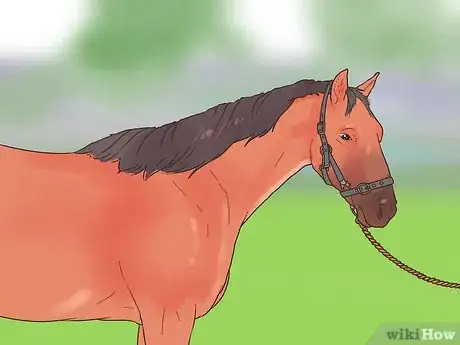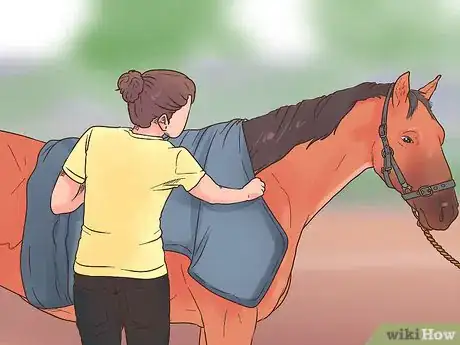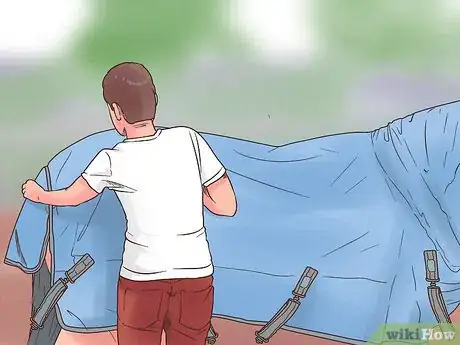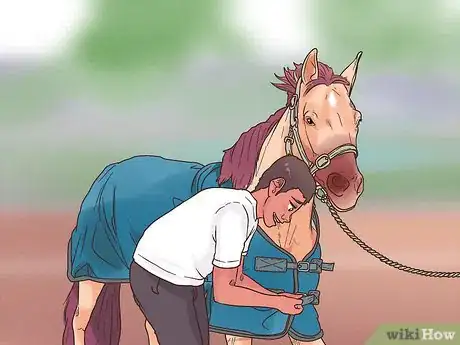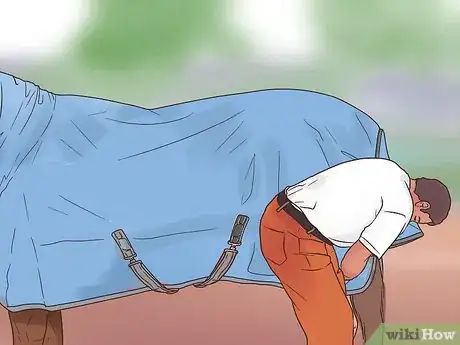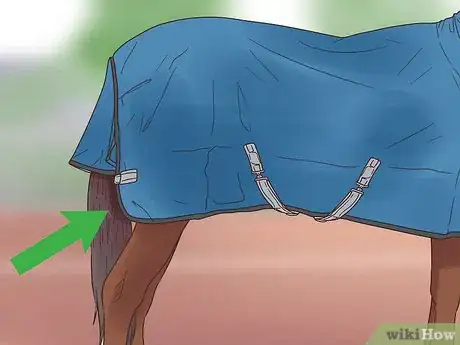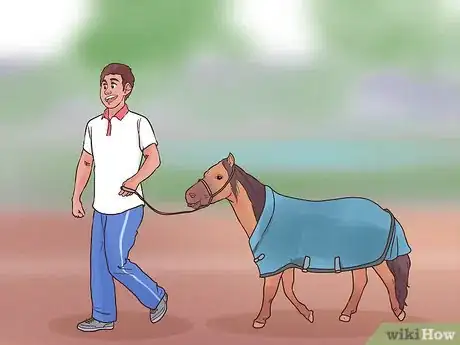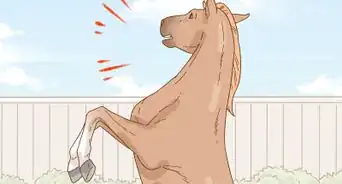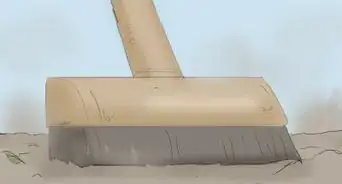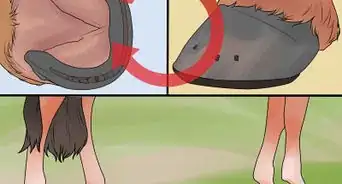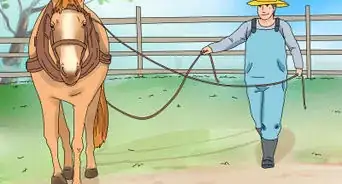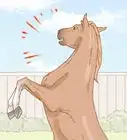This article was co-authored by Ryan Corrigan, LVT, VTS-EVN. Ryan Corrigan is a Licensed Veterinary Technician in California. She received her Bachelor of Science in Veterinary Technology from Purdue University in 2010. She is also a Member of the Academy of Equine Veterinary Nursing Technicians since 2011.
There are 9 references cited in this article, which can be found at the bottom of the page.
This article has been viewed 29,806 times.
A rug is like a blanket for horses and ponies and is designed to keep them warm in the chilly winter months. When putting the rug on a horse, be sure to fasten the straps securely, and not leave any dangling free. Make sure that your horse is tied up while you’re putting the rug on. If you’re inexperienced, have a more experienced rider nearby to supervise in case of an accident.
Steps
Positioning the Rug on the Horse or Pony
-
1Secure the horse in place with a headcollar. To prevent the horse from moving off while you’re putting the rug on, put the headcollar over the horse’s head and fasten it in place. Tie the headcollar’s lead rope to a wooden beam.[1]
- In the U.S., headcollars are known as halters.
-
2Fold the rug in half and lay it over the horse’s back. Walk to the horse slowly when you’re carrying the rug, and approach from the front so the animal can see you. Place the material over their back slowly and gently. Aim to set it directly in the center of the horse’s back. If you carelessly throw the rug over, it might frighten the horse or pony.[2]
- In the U.S., rugs are commonly known as blankets.
- Use slow movements to avoid scaring or startling the animal. Avoid throwing your arms up or moving suddenly.
- Make sure that the rug is facing the right way on the horse, so that the front and back of the rug are oriented towards the front and back of the horse. If the rug is on backwards, flip it around before you’ve fully unfolded it.
Advertisement -
3Unfold the rug on the horse’s back. Spread the folded rug out once it’s in place on the horse. The rug should cover the horse’s entire body, from their withers all the way back to their rear. It should hang a few inches below the horse’s belly while still allowing the animal to move freely.[3]
-
4Fasten the breast straps in front of the horse. Reach around the top of the horse’s neck and bring the rug together in front of the animal’s body. Fasten the breast straps together using the buckles or clips attached to the rug. Fasten these straps first in case the horse or pony panics and tries to run away.[4] If it does panic, the rug will slip backwards and the horse can step out of it without damaging the rug or harming itself.
- Note that the breast straps should easily overlap in the front and there should be enough room for you to put your hand between the rug and the horse.
- After you have fastened the breast straps, slide the rug backwards, so that it is farther down your pony’s neck, this makes the rug more comfortable for your horse or pony.
Securing the Rug Around the Horse or Pony
-
1Fasten the surcingles. These cross under the horse’s or pony’s belly and fasten to the rug on the opposite side. Start with the surcingle on the front-right of the horse. Bring it back across the horse’s belly and fasten it on the rear-left side of the rug. Then bring the right-rear strap and fasten it at the front-left of the rug.[5]
- When fastening the surcingles, avoid making them too tight around the horse’s stomach. You should be able to fit a fist between each strap and the animal’s belly.
- Make sure that the straps are in good working order to prevent one from falling off, which could cause the horse to get its leg caught in it.
- It may be helpful to have someone help you so you don’t have to crouch beneath the horse/pony to grab the surcingles in order to pull them under the horse to the side you’re standing on.
-
2Fasten the leg straps around your horse’s legs. Before they’re fastened, the long leg straps will hang down from the left side of the rug. Tuck the rear leg strap through and behind the horse’s legs, and fasten it to the clasp on the right-rear side of the blanket. Thread the front leg strap through the animal’s legs and fasten it back up on the left-rear side of the rug.[6]
- Do not stand directly behind the horse when fastening the leg straps. If startled, it may kick out with a hind leg.
- Rugs that are designed for ponies typically do not have leg straps. If you’re putting a rug on a pony, you can skip this step.
-
3Fasten the fillet string under the pony’s tail to keep the rug secure. Smaller rugs designed for ponies typically don’t have leg straps. Instead, they have a fillet string which fastens underneath the pony’s tail. Lift up the base of the pony’s tail and, under the tail, connect the fillet string from the left side of the rug to the right side. There should be a clip or clasp to hold the string in place.
- The fillet strap will function in the place of leg straps to hold the pony’s rug in place.
-
4Place the horse’s tail beneath the tail flap. Rugs for full-sized horses typically have a tail flap instead of fillet string. The tail flap keeps rain off of the tail and allows the horse to pick its tail up when it moves.[7]
- Tail flaps, compared to fillet strings, are mostly cosmetic and not necessary to hold the rug in place.
-
5Turn your horse or pony out to pasture. Take one more walk around the horse or pony and make sure that all of the straps are snug and firmly fastened in place. At this point, the rug is in place and the horse is ready to spend a day outside in the cold weather.
Warnings
- Be sure you know when to use a rug, which rug or sheet is appropriate for different kinds of weather, as well as which rug is best for your horse’s specific build and needs.⧼thumbs_response⧽
- A rug should only be put on if it is very cold outside, or if the horse is old or in poor health. Never put a rug on a horse or pony in hot weather. The rug will cause the horse to build up excess body heat, which can result in overheating and various other health problems. Healthy horses are adept at regulating their own body temperature, and are often comfortable without a rug in all but the coldest temperatures.[9]⧼thumbs_response⧽
References
- ↑ https://www.equus.co.uk/blogs/community/how-to-put-on-a-horses-rug
- ↑ https://youtu.be/viHHZ5RYbP4?t=23s
- ↑ http://www.proequinegrooms.com/tips/equipment-and-tack/checking-for-fly-sheet-and-blanket-fit/
- ↑ https://youtu.be/viHHZ5RYbP4?t=38s
- ↑ https://youtu.be/viHHZ5RYbP4?t=56s
- ↑ https://youtu.be/viHHZ5RYbP4?t=1m15s
- ↑ https://youtu.be/viHHZ5RYbP4?t=1m41s
- ↑ https://youtu.be/viHHZ5RYbP4?t=2s
- ↑ https://www.bluecross.org.uk/pet-advice/how-rug-horse
